From The Magazine ANTIQUES, March/April 2016. |
The fruits of extensive research on Benjamin Henry Latrobe’s 1808 house and furniture for William and Mary Waln begin with their impact on the aesthetic of the city itself.
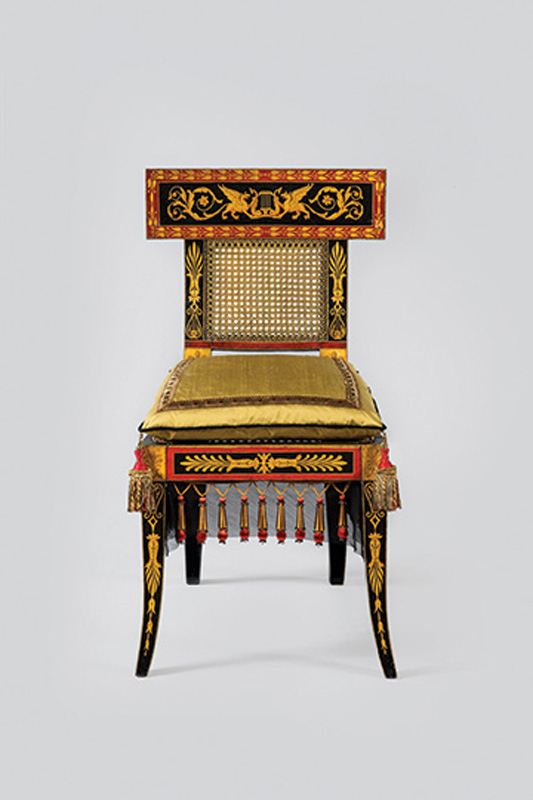
By the middle of the eighteenth century the “greene Country Towne” founded by William Penn in 1682 was bustling with commercial and social activity. Colonists from Europe and the British Isles who spoke a variety of languages and practiced a number of religions filled the city. Although the aura of the British and European Quakers who had followed Penn to Philadelphia was still palpable, ambitious merchants had begun to create New World versions of aristocratic styles and customs quite at odds with Quaker comportment and rules against “vain Needless things.”1 The founding in 1748 of a dancing assembly designed to create for the city’s merchants a life modeled on that of Britain’s landed gentry was one of these. Assembly events were not egalitarian affairs; artisans, shopkeepers, and mechanics did not receive invitations. The Quakers’ 1762 Rules of Discipline admonished against such exclusionary social activities, and Sarah Morris was dismissed from her Quaker meeting for “frequenting Houses for dancing, musick, and other Diversions, the Evil whereof, we have been concern’d to advise & caution her against.”2
Despite this atmosphere of admonishment against hierarchical social customs and “Superfluity & Excess in Buildings and Furniture,” many Philadelphia Quaker and non-Quaker artisans and their patrons did embrace the luxury of contemporary European and Asian styles. Several families with long Quaker heritages, such as John and Elizabeth Lloyd Cadwalader, commissioned grand houses replete with elaborate furnishings made abroad but also in Philadelphia, where local artisans were well trained in the manufacture of worldly goods that mimicked—and often surpassed—those made in Edinburgh, London, France, Italy, India, and China.
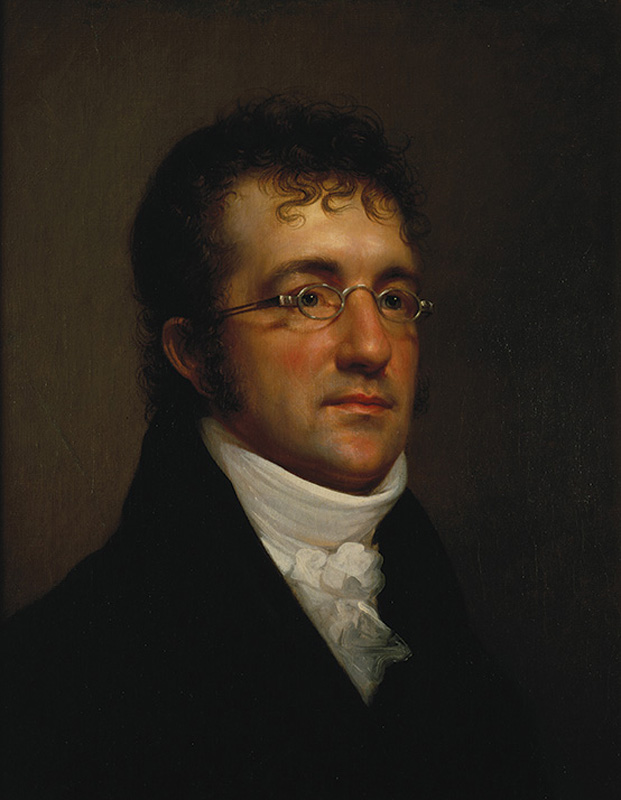
The taste for aristocratic style persisted in the city’s public and private spheres even after the Revolution. In 1794, when Philadelphia, as capital of the United States, played host to the president, Congress, and masses of foreign emissaries, the British journalist Henry Wansey described the space where the assembly was held as “a most elegant room. . . . It was papered after the French taste, with the Pantheon figures in compartments, imitating festoons[,] pillars, and groups of antique drawings, in the same style as lately introduced in the most elegant houses in London.”3
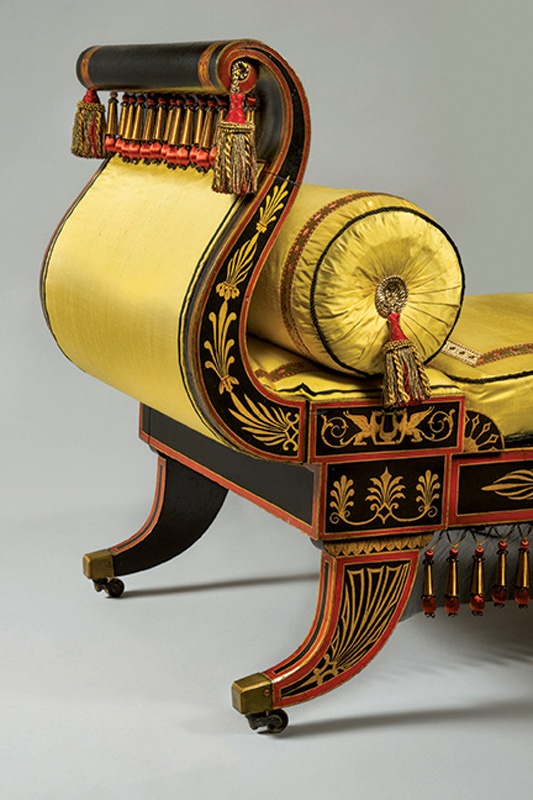
By 1805 the city was no longer the nation’s capital, but it was about to witness the creation of its most innovative, resplendent, and potent interior—the work of a team of artisans commissioned by a Quaker merchant and his socially adept Episcopalian wife. British-born architect Benjamin Henry Latrobe—known as Henry—had arrived in the city in early spring 1798 and had already completed several commissions: the Bank of Pennsylvania in the plain Greek revival style (see Fig. 4); the domed Pump House for the Centre Square Water Works (completed in 1801, demolished in 1829);4 and a Gothic-style country house in Fairmount Park for the merchant William Cramond called Sedgeley (completed in 1802, demolished around 1857). Latrobe had also established himself in Philadelphia society by marrying Mary Elizabeth Hazlehurst (1771–1841), the daughter of Isaac and Johanna Purviance Hazlehurst—a prominent couple with family, commercial, and political ties in Philadelphia, Baltimore, and Salem, New Jersey.
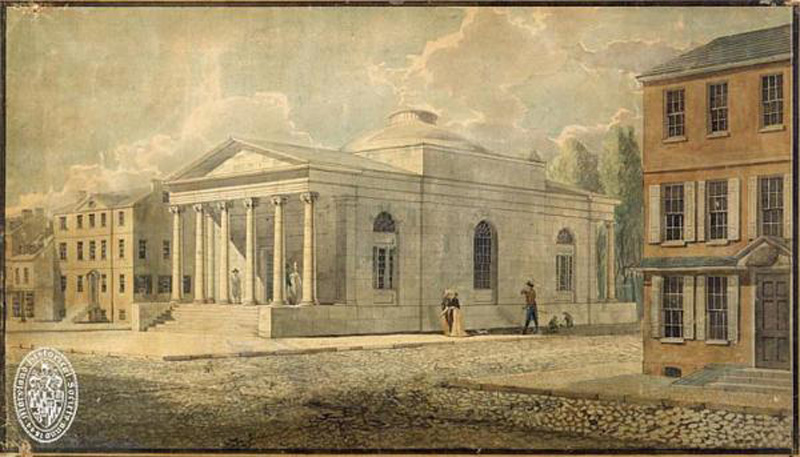
Philadelphia merchant William Waln, the son of the Quaker preacher Nicholas Waln (1742–1813), had made a bold departure from his faith when he was married by Episcopal Bishop William White to Mary Wilcocks on March 14, 1805, at Christ Church, Philadelphia. But what the couple did next in commissioning Henry Latrobe to design and oversee the building of their magnificent house and its furnishings was even bolder: they unleashed Latrobe to design for them furniture that directly imitated ancient furniture, moving once and for all beyond the restrained bounds of mere references to classical art, and transforming Philadelphia’s—and indeed America’s—interpretation of classical art. As a conspicuous display of the Walns’ wealth and worldly aspirations, the house and its interiors were meant to raise eyebrows; they did so while also placing Philadelphia in the vanguard of classical taste. The house reigned over the southeast corner of Chestnut and Seventh Streets until it was demolished in 1847. It is known today through two fire insurance surveys (1824 and 1845) and a watercolor (Fig. 6).
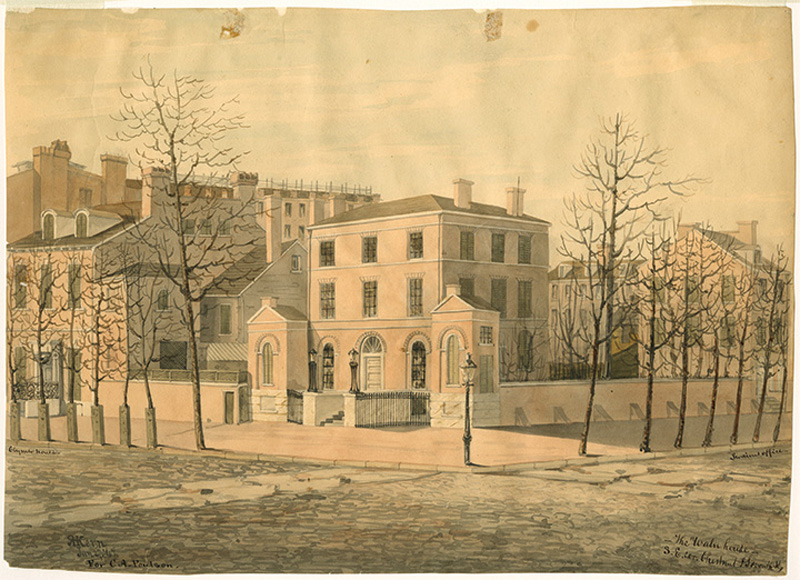
Planning for the new house began within two weeks of the couple’s wedding. Latrobe’s response to the initial request is dated March 26, 1805; in it he offers floor plans and expresses his preference for American houses based more on the French model than the British: “In America our manners are English, but our climate is in almost every particular the contrary of the climate of the British Islands. Our buildings however are exact copies of those erected in Great Britain especially the dwelling houses of our cities. Their arrangement there is not badly adapted to our habits and our prejudices, but our climate renders them faulty in many most important points…in the important points of convenience and privacy the French designs are as superior to those of England, as the latter to the French in neatness, and correction of execution.”5
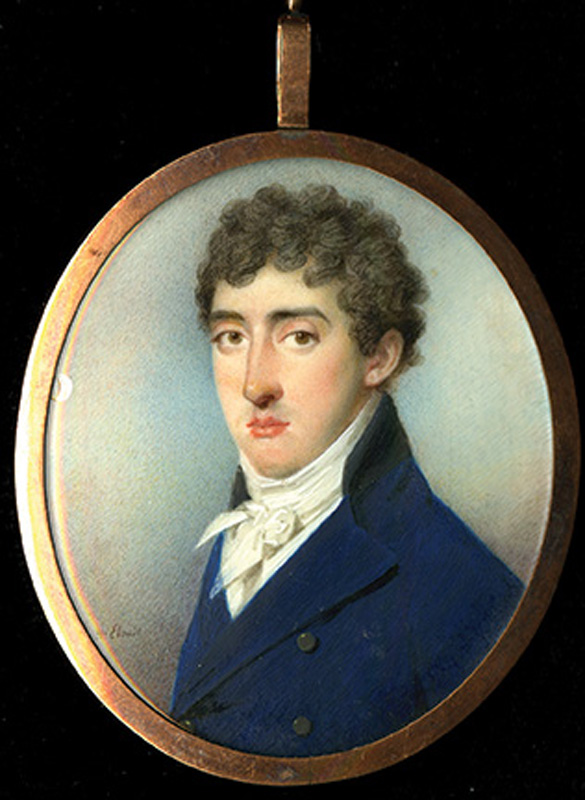
By early 1807 Waln had accepted Latrobe’s design and acquired three contiguous lots one block from the former State House and plumb in the middle of Philadelphia’s booming theater and social district. The couple asked Latrobe to create a fully integrated drawing and dining room suite—a welcome opportunity for him, as he was generally occupied with large-scale public commissions.6 The plans for these rooms suggest that they were meant to integrate a new taste in interior furnishings with a similarly novel approach to the overall plan of the house, thereby setting a standard for Philadelphia drawing rooms. The city and her people were poised for such innovation: an active port and a central location between the southern and northern United States—with connections to fashionable people in Mexico City, New Orleans, New York, Boston, Newport, Baltimore, Richmond, and Charleston—exposed Philadelphians to an international style that they would inevitably expect to see reflected in the architecture and interiors around them.
On March 3, 1807, Latrobe wrote to Waln that he was leaving his protégé Robert Mills (1781–1855) to oversee the building of the house. His letters to Mills in the summer and fall of 1807 concerning the house and other projects provide some clues about the interior finish: “the Jaumbs will be very wide and contain all the Shutters, as in Mr. Waln[’]s drawing room.”7 On September 20, 1807, Latrobe wrote to Mills that he was “glad to find Mr. Waln’s house so much advanced,” and three days later that a “Sky Light will be the best thing for Mr. Waln’s.”8
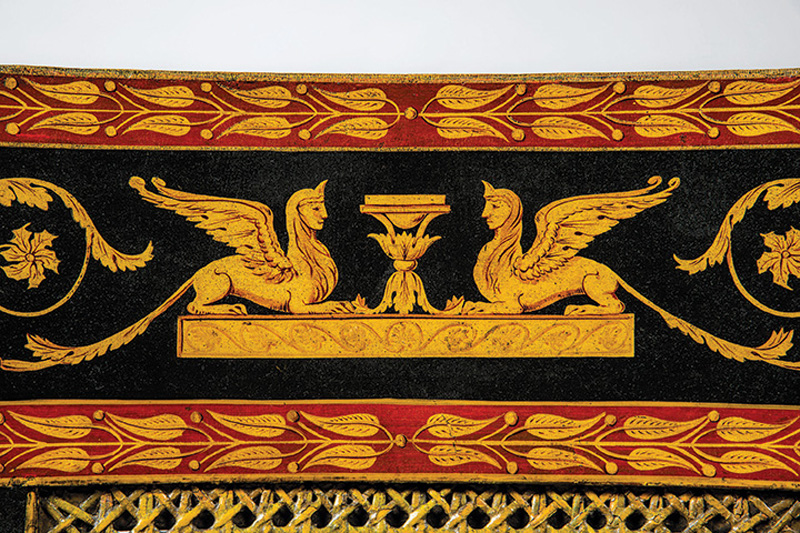
In 1808, after avoiding the subject of the interior and its furniture for more than a year, Latrobe finally focused on the Walns’ two south-facing drawing rooms, one of which he consistently referred to as the dining room. He identified the London-trained artist George Bridport, whose talent and disposition he held in tremendous esteem, as the person who could satisfy the Walns’ wishes with respect to the interior’s decorative architecture. Latrobe wrote Bridport in August 1808: “I have resolved to decorate his [Waln’s] drawing room frieze, which is more than two feet broad with Flaxman[’]s Iliad or Odyssey in flat Etruscan color, giving only outline on a rich ground. I should propose stenciling it.”9 He and Bridport may have discussed the design or even made a draft of it based on rooms familiar to them—possibly those at Osterley in Hounslow, outside of London, and especially at Packington Hall in Warwickshire, where Joseph Bonomi (1739–1808) sourced the same Continental designers whose publications Bridport maintained in his library (see Fig. 8). Latrobe’s cursory instructions reveal that he trusted Bridport to apply his artistic sensibilities to the room’s decoration.
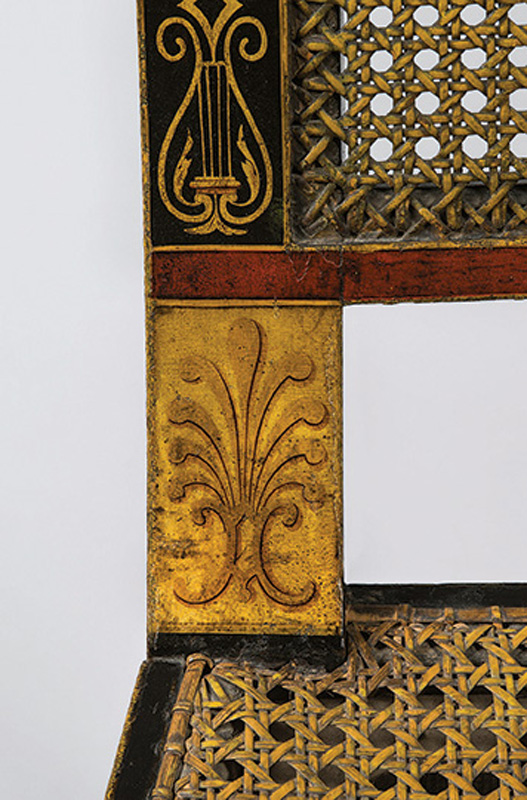
These directives to Bridport provide our primary understanding of how the drawing rooms were painted: no detailed descriptions of the finished rooms survive, and the 1824 and 1845 insurance surveys of the house summarily note only that the “ornamental Paint work in the Drawing Rooms is excepted from the Insurance.”10 The directives specify a string of painted panels running along the frieze above the windows, doors, fireplaces, and mirrors, similar to those found in a perspective drawing by Latrobe dating from 1797–1798 for a proposed (but unexecuted) “assembly room” in Richmond (Fig. 7). The linear “stenciling” was a direct reference to the decoration of ancient Greek pottery, and the source for the images, as indicated by Latrobe’s letter, was John Flaxman’s illustrations of the Iliad and Odyssey, which had been published in London ten years earlier.11 Latrobe specified that the ground was to be painted in a rich, presumably dark, color—evoking the hue used for figures on Greek red-figured pottery.
For the furniture, twenty-one pieces of which survive,12 the tastes of Latrobe and the Walns merged to produce the most spectacular and original set Philadelphians had yet seen. Mary Waln, whom Latrobe consistently acknowledged as leading the charge for the house and its furnishings, preferred French taste, which would have brought her to New York to see the work of French designers and cabinetmakers. Latrobe joined her, her husband, and other family members there in late August 1808. Exactly what they were doing is not fully documented, but Latrobe’s correspondence immediately upon his return and the resulting furniture suggest they were scouting out furniture in the French classical style for the drawing room. Latrobe wrote to his wife in Washington on August 21 that he had completed his business with the Walns in New York, but that her friend Mary Waln had “been seized with a fever and ague. . . and I fear not likely to enjoy much health in her new house, in which she interests herself most eagerly.”13 The latter remark was an accurate foreshadowing of the ill health partially associated with childbearing that long afflicted Mary Waln.
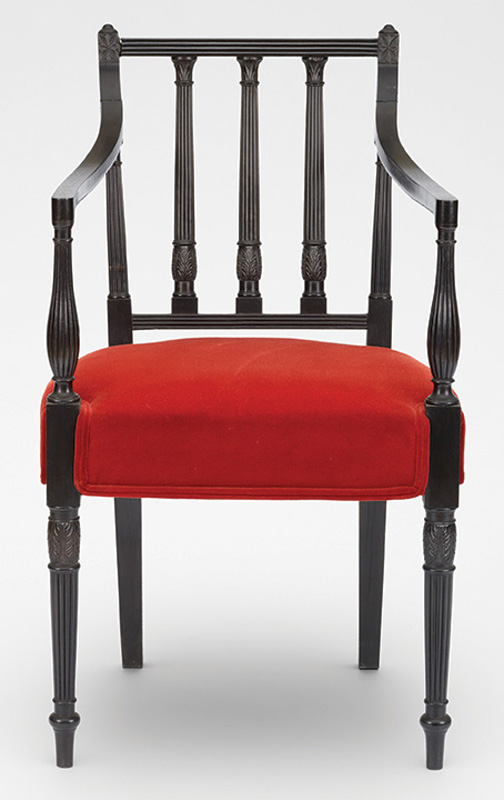
Later that same week, Latrobe wrote to the Walns, who were still in New York, about his progress with the furniture: “I shall see a pattern chair tomorrow morning. I have ordered the cushions to be takable off as I proposed….The drawing of the sideboard goes to Aiken’s tomorrow morning.”14 Here, Latrobe names Scottish émigré John Aitken—one of Philadelphia’s leading furniture makers, whose shop was on the same block as the Walns’ house—as the maker of the chairs and sideboard, and he most likely made or oversaw the creation of the card tables, sofa, and smaller settee as well.15 The correspondence documents that Aitken worked directly with Latrobe on the prototype chair—probably the one in Figure 1, which stands out from the rest of the set in dimensions, woods, and precision of construction and painted decoration. He almost certainly had a bevy of journeymen and specialists to execute the remainder of the set under his supervision.
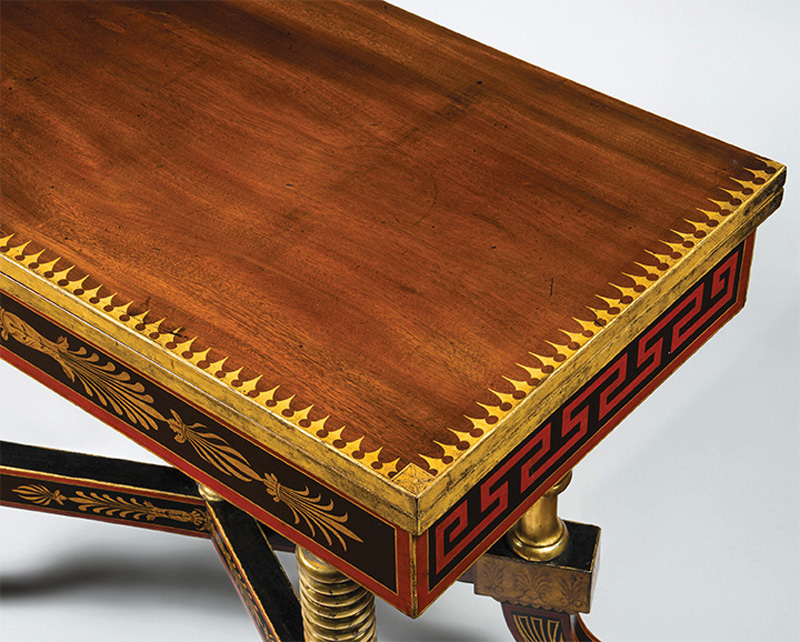
The furniture that Latrobe designed and Aitken made was influenced by contemporary French designs that closely imitated classical furniture and drew on the designs of English architect Charles Heathcote Tatham. Its impact came from its departure from the familiar interpretation of neoclassicism with which Philadelphia patrons and artisans had become accustomed—such as the restrained elegance of the ebony drawing room furniture Ephraim Haines had made for merchant Stephen Girard less than a year earlier (see Fig. 13).
From all accounts, Bridport arrived in late October and executed the wall painting and the complex and sophisticated arrangements of ornament on the furniture. Given the relatively short time it took to complete the work—evidently less than three months—and the variations in the lines and framing features, he must have led a team of artists who assisted with certain parts.16 But for the main events on each piece, Bridport showed off his skill in masterful freehand work. As Latrobe had for such elements as the turned columns on the sideboard, Bridport derived his inspiration from Charles Heathcote Tatham’s Etchings Representing the Best Examples of Ancient Ornamental Architecture, Drawn from the Originals in Rome and Other Parts of Italy (1799), a copy of which was listed in his estate inventory.17 Bridport painted the central elements of the chairs’ crest rails with an especially deft hand, displaying a keen eye and a delicate touch with his materials, including generous amounts of gold, and an equally sure sense of the effects of light on the surfaces (see Fig. 11). Now, after a comprehensive five-year treatment undertaken by conservator Peggy A. Olley on the ten pieces of furniture at the Philadelphia Museum of Art, the clarity and crispness of the lines, the quality and skill of the execution, and the individuality of the painted ornament can be seen. Along with a great deal of new research we now have a deeper understanding of this groundbreaking furniture.
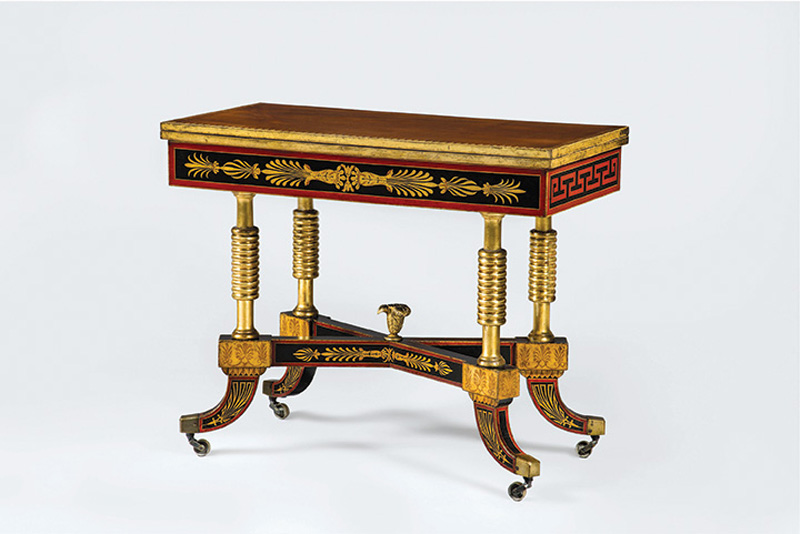
The sleek lines of the klismos designs revolutionized furniture-making in Philadelphia: the Walns’ seating furniture, card tables, and sideboard stepped outside of the box in every way—form, ornament, and upholstery—and embraced a new type of classical revival. The Walns’ klismos chairs mimicked ancient bronze furniture, and the brilliant decorative painting and gilding suggested gilt mounts also seen on ancient furniture.
William and Mary Waln’s selection for their drawing room furniture was soon underscored by Latrobe’s choice of the same style for his 1809 designs for James and Dolley Madison’s oval drawing room furniture at the President’s House in Washington (made in Baltimore at the manufactory of John and Hugh Finlay).18 After the Walns’ 1808 commission, the delicate references to classical style vanished, and Philadelphia—and indeed America—ushered in a new fashion in classical revival interiors.
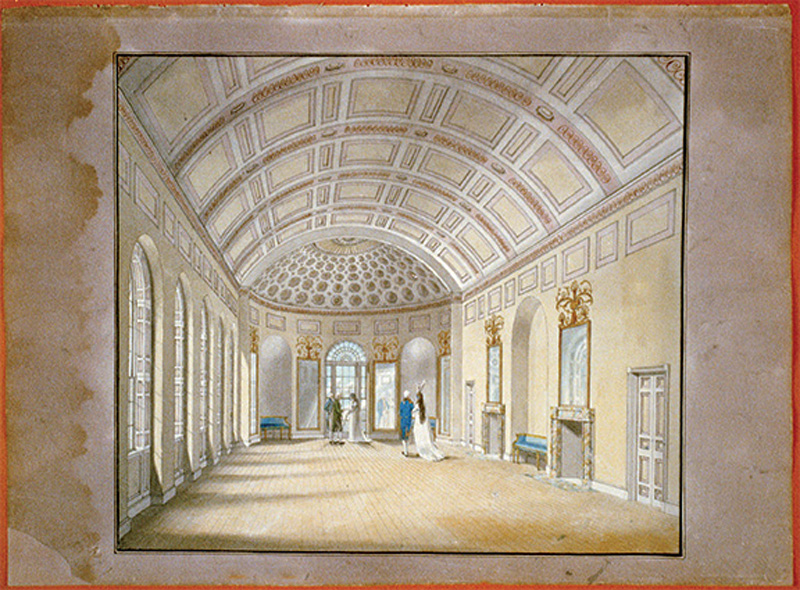
By 1821 the winds of fortune had shifted and William Waln found himself overextended in what had long been a lucrative trade with China. They remained dignified through their financial troubles, but William and Mary Waln were forced to sell their household furnishings to pay creditors. A recently discovered advertisement describing the sale in Poulson’s American Daily Advertiser for Saturday November 3, 1821, offers a glimpse into how the Latrobe furniture was viewed thirteen years after it was made.19 It reads: “SPLENDID FURNITURE at AUCTION/At the late residence of Mr. Waln, Corner of Chestnut & Seventh Streets….The furniture is of the richest kind, amongst which is the following—elegant French Carpets with medallion Centre pieces, elegant Bronze and Gilt Chairs, covered with Satin, Sofas to match, Window Curtains, elegant Pier Tables, with Chifanurs, elegant Pier Tables, with marble tops and Mermaids below, elegant Lustres for middle of rooms, Sideboards to match, large Mirrors very elegant, a set of French Porcelaine.”20
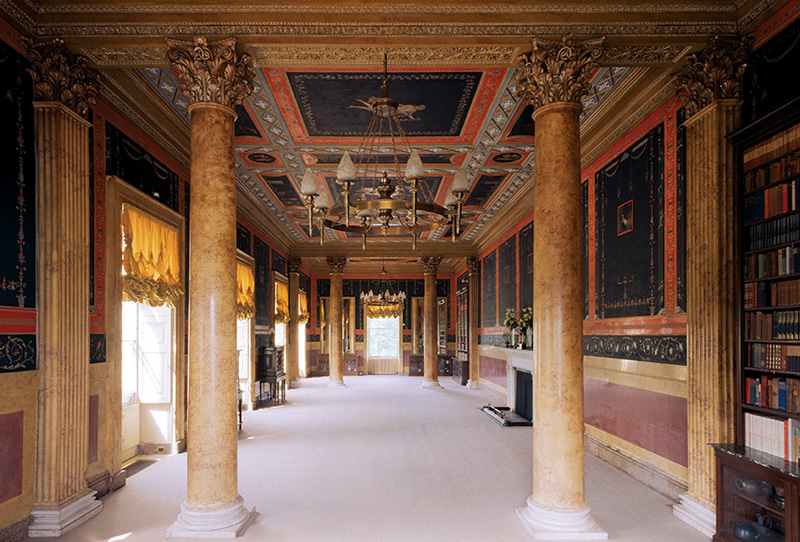
While the advertisement for the sale of the Walns’ furniture lists the most extravagant pieces, Philadelphia educator and philanthropist Rebecca Gratz (1781–1869) offered her more personal observations following a stroll on Chestnut Street on November 7, 1821, the day before the sale was to take place:
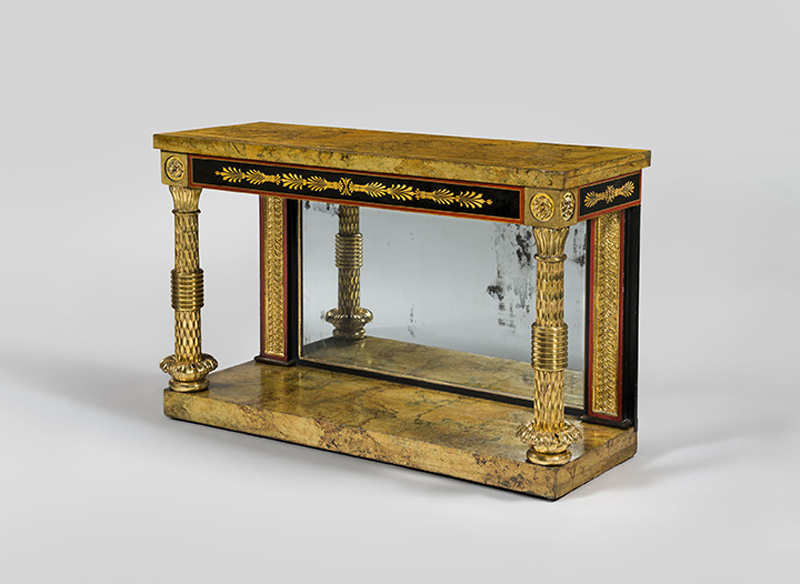
Today Chestnut Street has been a scene of gaiety— on an occasion which would make a moralist, or an observer of human affairs quite sad—the splendid furniture of a ruined gentleman, was exhibited for sale, and tomorrow will be distributed under the auctioneers hammer to the four corners of the city—the luxuries which wealth and ambition & taste had combined to render the most beautiful I ever saw, Mrs. Waln’s drawing-room was certainly more like an apartment in an eastern fairy tale, than a Phila parlour—I wish you could have seen it for I confess I had no idea of its grandeur—and cannot compare any furniture I had ever before seen with it—alas alas! her French carpets were this day trodden by many a clownish foot—and her mirrors reflected objects, which it would have shocked her nerves to witness in the retirement of her dressing room—but “fallen from her high estate,” she will I believe acknowledge that happiness does not always dwell with riches—she is more sensible of her powers to make comforts, than she formerly was, to enjoy them—activity has restored health, and adversity produced an energy she never called into action before.21
Clearly, Gratz, herself a member of a prominent and wealthy family, was impressed by the Walns’ furnishings and what they symbolized for the city of Philadelphia. Latrobe may have expressed this best in his 1811 oration when he declared that “the days of Greece may be revived in the woods of America and Philadelphia become the Athens of the Western World.”22 PMA’s ten pieces of Waln furniture remind us of a high-water moment in the city’s aspirations as well as the contradictions—and potential pitfalls—inherent in those aspirations, something Latrobe understood quite well. In 1809 he remarked to the Walns’ neighbor George Harrison that in America’s elegantly appointed drawing rooms, “we were jammed between our republican principles & our aristocratic wishes.”23
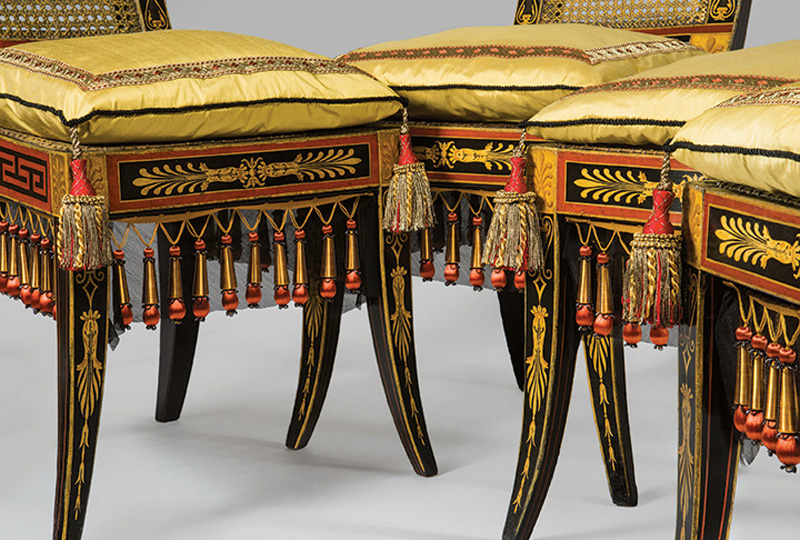
This article draws on research for Classical Splendor: Painted Furniture for a Grand Philadelphia House, which will be on view at the Philadelphia Museum of Art from September 3 to January 1, 2017. The show will be accompanied by a catalogue by Alexandra A. Kirtley and Peggy A. Olley with an essay by Latrobe scholar Jeffrey A. Cohen, and architectural renderings and conjectural floor plans by James B. Garrison.
ALEXANDRA ALEVIZATOS KIRTLEY is the Montgomery Garvan Curator of American Decorative Arts at the Philadelphia Museum of Art.
1Thomas Story, Discourses Delivered in the Publick Assemblies of the People called Quakers (London, 1738), p. 70. 2 See Sarah Fatherly, Gentlewomen and Learned Ladies: Women and Elite Formation in Eighteenth Century Philadelphia (Lehigh University Press, Bethlehem, Penn., 2008), p. 99; and Henry Wansey, The Journal of an Excursion to the United States of North America in the Summer of 1794 (London, 1796), p. 132 (entry for June 6, 1794). Emphasis is also given to the role of the Dancing Assembly in colonial Philadelphia in Recollections of Joshua Francis Fisher Written in 1864, arr. Sophia Cadwalader (1929), such as on pp. 47–48, 69. Subscribers to the Dancing Assembly included members of the Bond, Burd, Chew, Duché, Hamilton, Inglis, Lardner, McCall, Mifflin, Penn, Peters, Plumsted, Powel, Shippen, Swift, Tilghman, Wallace, and Willing families, as well as two prominent Jewish families, the Franks and Levys. Noticeably absent from the subscription were Quakers who maintained their simplicity, such as the Emlens, Logans, Morrises, Norrises, Pembertons, and the family of Nicholas Waln. See the Morris entry cited in Fatherly, Gentlewomen and Learned Ladies, p. 99. 3 Wansey, The Journal of an Excursion, entry for June 6, 1794. For more on the culture of Philadelphia’s dance assemblies, see Lynn Matluck Brooks, “Emblem of Gaiety, Love, and Legislation: Dance in Eighteenth-Century Philadelphia,” Pennsylvania Magazine of History and Biography, vol. 115, no. 1 (January, 1991), pp. 64–87. Frenchman Moreau de St. Méry’s journal describes the “snobbery in Philadelphia, where classes are sharply divided…particularly noticeable at balls…where no one is admitted unless his professional standing is up to a certain mark” (Moreau de St. Méry’s American Journey, 1793–1798, trans. and ed. Kenneth Roberts and Anna M. Roberts [Doubleday & Company, New York, 1947], pp. 290–291, 333). See also a blog entry by Bob Skiba for July 7, 2014, philadance historyjournal.wordpress.com 4 For more on this building, see philadelphiaencyclopedia.org 5 Latrobe to Waln, March 26, 1805, in Correspondence and Miscellaneous Papers of Benjamin Henry Latrobe, ed. John C. Van Horne and Lee W. Formwalt, vol. 2 (Maryland Historical Society and Yale University Press, New Haven, 1986), pp. 25–36 [hereafter, Corr.]. 6 For a comprehensive catalogue of Latrobe’s domestic commissions, see Michael W. Fazio and Patrick A. Snadon, The Domestic Architecture of Benjamin Henry Latrobe (Johns Hopkins University Press, Baltimore, 2006). The research of this author, Jeffrey A. Cohen, Peggy A. Olley, and James B. Garrison produced a different floor plan for the Walns’ house than the one proposed by Snadon and Fazio. See forthcoming PMA exhibition catalogue. 7 Latrobe to Robert Mills, July 23, 1807, in Corr. vol. 2, p. 455. 8 Latrobe to Mills, September 20, 1807, ibid., p. 487; and September 23, 1807, in The Papers of Benjamin Henry Latrobe: The Microtext Edition, ed. Edward C. Carter II (James T. White, Clifton, NJ 1976), 59/G7 [hereafter Papers]. 9 Latrobe to George Bridport, August 7, 1808, in Corr., vol. 2, p. 647. 10 Philadelphia Contributionship for the Insurance of House from Loss by Fire, Policy Number 6381, October 14, 1845. A similar exception is also included in the 1824 survey, Philadelphia Contributionship for the Insurance of House from Loss by Fire, Policy No. 4325, September 30, 1824. For images of the originals, go to philadelphiabuildings .org/pab. 11 When Bridport died, in 1819, his library included “Flaxman’s Historical Designs from The Iliad, Odyssey, and 3 Tragedy of Aeschylus,” although it is not known when he acquired the volumes. Inventory no. 60, April 26, 1819, examined and valued by John Cliffton and John Haviland, April 30, 1819, Philadelphia City Archives. 12 In addition to the ten pieces at the Philadelphia Museum of Art, which have recently been conserved, another nine chairs, a settee, and a card table survive elsewhere—not recently conserved. 13 Latrobe to Mary Elizabeth Latrobe, August 21, 1808, in Corr., vol. 2, p. 652. 14 Latrobe to Waln, August 21, 1808, in Papers, 65/F8. Latrobe consistently misspelled names: Aitken as Aiken; Rae as Rea or Ray; Finlay as Findley or Findlay. 15 Joinery and materials are consistent across the set and typical of contemporary Philadelphia furniture. 16 Latrobe wrote Waln on May 30, 1811, outlining payments for work completed on the house, declaring that “I have paid 200$ to Mr. Bridport who then was in my office at 2.50 pr day, & who made all the final drawings at least 50.” This calculates into 80 days of work. Latrobe to Waln, May 30, 1811, in Papers, 85/E12. 17 Inventory no. 60, April 26, 1819, Philadelphia City Archives. Tatham and Latrobe both worked for London architect Samuel Pepys Cockerell, overlapping in his office for a time. 18 Alexandra Alevizatos Kirtley, “Contriving the Madisons’ drawing room: Benjamin Henry Latrobe and the furniture of John and Hugh Finlay,” The Magazine Antiques, vol. 176, no. 6 (December 2009), pp. 56–63. 19 An advertisement on March 7, 1821, in Poulson’s American Daily Advertiser has been cited for years as possibly describing the sale of the Walns’ furniture, but it was actually for the sale of furniture belonging to Samuel Boyer Davis (1766 –1854), a native of Lewes, Delaware, and hero of the War of 1812, and his wife, Sally Jones Davis. Philadelphia city directories of 1819, 1820, and 1821 and the advertisement give their address as “no. 178 Chestnut Street, opposite the Masonic Lodge,” which was located between Seventh and Eighth Streets; the Walns lived at number 156 Chestnut, between Sixth and Seventh, which was one block east of the Masonic Lodge. Furthermore, the Walns were liquidating their furnishings because they were bankrupt, while the furniture at number 178 was being sold because the owners were “going to Europe.” The letter in n. 21 gives the same sale date. 20 In addition to the Aitken furniture, the advertisement refers to furniture acquired in two redecorations, which can now be documented to the eight-year hiatus between December 1810 and 1818 when Mary Waln did not give birth, perhaps as a result of her continually weak state of health. 21 Rebecca Gratz to Maria Gist Gratz, November 7, 1821, in Letters of Rebecca Gratz, ed. David Philipson (Jewish Publication Society of America, Philadelphia, 1929), p. 48. The author thanks Judith M. Guston of the Rosenbach Museum and Library for suggesting Gratz’s letters as a possible source for references to the Walns. 22 Benjamin Henry Latrobe, Anniversary Oration: Pronounced before the Society of Artists of the United States… (Philadelphia, 1811), p. 17. 23 Latrobe to George Harrison, June 20, 1809, in Papers, 69/E5.
